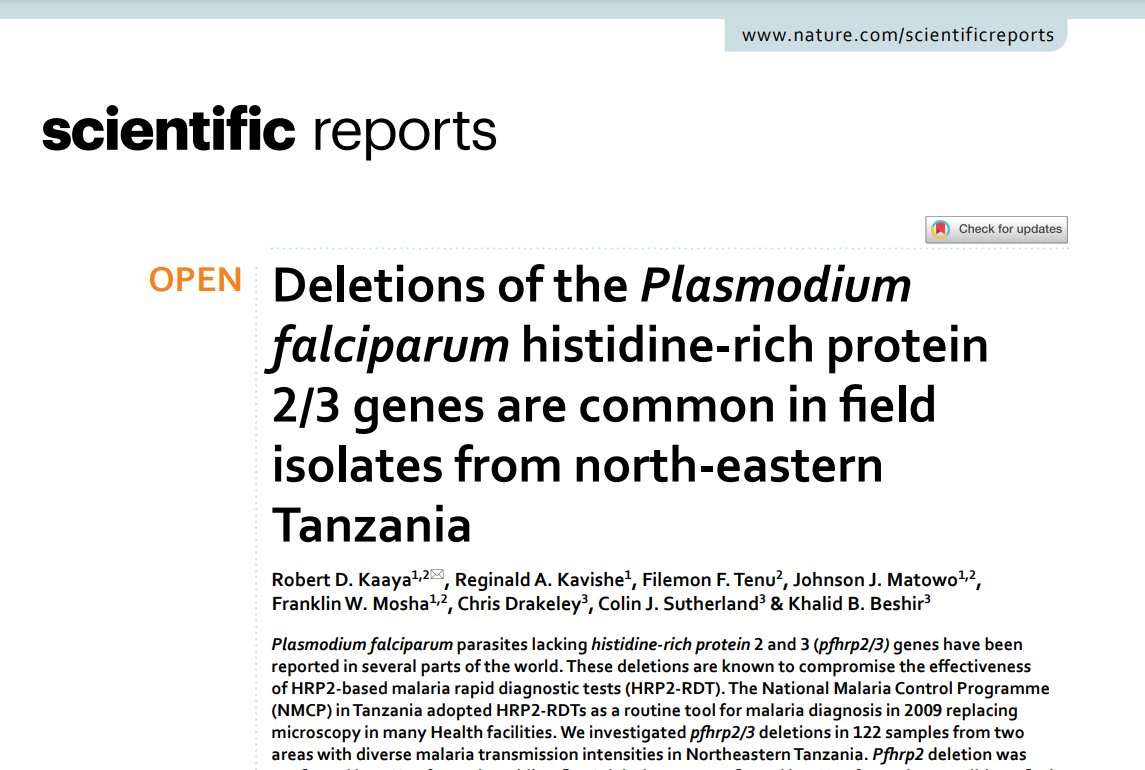- Published:
Abstract
Plasmodium falciparum parasites lacking histidine-rich protein 2 and 3 (pfhrp2/3) genes have been reported in several parts of the world. These deletions are known to compromise the effectiveness of HRP2-based malaria rapid diagnostic tests (HRP2-RDT). The National Malaria Control Programme (NMCP) in Tanzania adopted HRP2-RDTs as a routine tool for malaria diagnosis in 2009 replacing microscopy in many Health facilities. We investigated pfhrp2/3 deletions in 122 samples from two areas with diverse malaria transmission intensities in Northeastern Tanzania. Pfhrp2 deletion was confirmed in 1.6% of samples while pfhrp3 deletion was confirmed in 50% of samples. We did not find parasites with both pfhrp2 and pfhrp3 deletions among our samples. Results from this study highlight the need for systematic surveillance of pfhrp2/3 deletions in Tanzania to understand their prevalence and determine their impact on the performance of mRDT.
Introduction
Malaria continues to be a health problem in Sub-Saharan Africa (SSA), where the 10 countries with the highest infection rates and deaths in the world are found1. A recent resurgence of the disease is evident in areas where a significant decline in malaria cases was previously observed and this inevitably calls for scrutiny of the malaria control interventions currently in use1, which comprise a number of strategies1,2. Artemisinin-based combination therapy (ACT) is the approved regimen for malaria treatment3. The World Health Organization (WHO) recommends for parasitological confirmation to be carried out before this treatment is provided4. Microscopy, although still regarded as the gold standard in malaria diagnosis, faces several operational challenges5,6. In the resource-limited settings of SSA, shortage of personnel with expertise, and long turn-around time of results from the laboratory have been identified as obstacles to the effective microscopic diagnosis of malaria, particularly in rural settings7,8.
Rapid diagnostic tests have proven to be reliable and sensitive enough to replace microscopy as a routine technique for malaria diagnosis in symptomatic patients9. The National Malaria Control Program (NMCP) in Tanzania rolled out malaria Rapid Diagnostic Tests (mRDT) in 2009, achieving diagnostic coverage of around 90% in public and private health facilities in 2014, with microscopy being used in the remaining 10% of facilities in the country10. Over 80% of mRDTs manufactured worldwide are sold or distributed in SSA. Tanzania Medicines and Medical Devices Authority (TMDA) approved five brands of mRDTs to be used in Tanzania11. Accredited Drug Dispensing Outlets (ADDOs) sells an average of 40 RDT units every week, most of them are HRP2-based and there are more than 6000 outlets in Tanzania mainland12,13. Rapid diagnostic tests have different detection thresholds, but sensitivity and specificity decrease when parasitaemia is below 200 parasites/µl14,15. Given the high detection threshold, mRDT might miss malaria parasites that are at low densities.
The majority of mRDTs distributed in the SSA are for Plasmodium falciparum detection16, mostly utilizing the histidine-rich protein (HRP2), as the antigenic marker. HRP2 is a 60–105 kD water-soluble protein secreted by P. falciparum trophozoites (asexual stage), encoded by the sub-telomeric pfhrp2 locus on chromosome 817,18. HRP2 is abundantly secreted and easily detected in the peripheral blood circulation of the host even when the parasite has sequestered in the microvasculature of the organs19,20, making the protein an important diagnostic target.
Studies in the last decade have reported the presence of P. falciparum parasites lacking both the loci encoding HRP2 and its isoform HRP3 (encoded by pfhrp3), which has sufficient similarity to HRP2 and is recognised by the monoclonal antibodies used on the RDT test strips. P. falciparum parasites lacking the locus are thus not detected by HRP2-RDT. In the Amazon region of South America, these deletions have a reported prevalence of 28.6%, leading to recommendations to immediately stop using HRP2–RDTs21. Evidence from Asian countries also suggests the presence of P. falciparum lacking pfhrp2, including in India with a prevalence of 4%22 and China-Maynmar border with a prevalence of 5%23. Across Africa, Eritrea reported the highest prevalence of pfhrp2 and pfhrp3 deletions of 80.8% and 92.3%, respectively, which prompted a switch to non-HRP2-RDTs24,25. Studies elsewhere in East Africa also showed evidence of low proportions of pfhrp2/3 gene deletions from field isolates26,27,28,29.
As Tanzania embarks on a malaria pre-elimination strategy, RDTs will play a crucial role in case detection, and assessment of their performance is vital. This study set out to assess the performance of HRP2-RDTs in two areas in Tanzania with different malaria transmission intensities.



